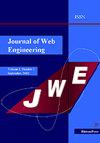Software Practice and Experience on Smart Mobility Digital Twin in Transportation and Automotive Industry: Toward SDV-Empowered Digital Twin Through EV Edge-Cloud and AutoML
IF 0.7
4区 计算机科学
Q4 COMPUTER SCIENCE, SOFTWARE ENGINEERING
引用次数: 0
Abstract
A digital twin is a virtual representation of a physical asset that serves as a pivotal convergence technology that facilitates real-time prediction, optimization, monitoring, control, and improved decision-making. It can be widely applied to various domains, such as automotive, manufacturing, logistics, and smart cities. The automotive industry, in particular, is actively integrating digital twins throughout the product life cycle, from research and development, production, sales, and services to enhance the overall customer experience. This paper presents insights and lessons learned on software practice and experience related to implementing smart mobility digital twins, focusing on the potential of transportation digital twins built from data collected by electric vehicles (EVs) with EV edge cloud and automated machine learning (AutoML). Despite current limitations in data sufficiency, we forecast that, as the SDV trend accelerates and the adoption of EVs increases, the digital twin will become essential for the intelligent transportation system (ITS) in future smart cities, enabling accurate traffic predictions even in areas with limited road infrastructure. The successful integration of real-time data, high-performance prediction models, and automated service environments will enhance the effectiveness toward an SDV edge-empowered transportation digital twin.交通和汽车行业智能移动数字孪生的软件实践与经验:通过电动汽车边缘云和自动驾驶实现sdv支持的数字孪生
数字孪生是物理资产的虚拟表示,它是一种关键的融合技术,可以促进实时预测、优化、监测、控制和改进决策。可广泛应用于汽车、制造、物流、智慧城市等各个领域。特别是汽车行业,正在积极地将数字孪生体整合到整个产品生命周期中,从研发、生产、销售到服务,以增强整体客户体验。本文介绍了与实施智能移动数字孪生相关的软件实践和经验的见解和经验教训,重点介绍了基于电动汽车(EV)收集的数据构建的交通数字孪生的潜力,这些数据具有EV边缘云和自动机器学习(AutoML)。尽管目前数据不足,但我们预测,随着自动驾驶汽车趋势的加速和电动汽车的普及,数字孪生体将成为未来智慧城市智能交通系统(ITS)的关键,即使在道路基础设施有限的地区也能实现准确的交通预测。实时数据、高性能预测模型和自动化服务环境的成功集成将提高SDV边缘授权交通数字孪生的有效性。
本文章由计算机程序翻译,如有差异,请以英文原文为准。
求助全文
约1分钟内获得全文
求助全文
来源期刊

Journal of Web Engineering
工程技术-计算机:理论方法
CiteScore
1.80
自引率
12.50%
发文量
62
审稿时长
9 months
期刊介绍:
The World Wide Web and its associated technologies have become a major implementation and delivery platform for a large variety of applications, ranging from simple institutional information Web sites to sophisticated supply-chain management systems, financial applications, e-government, distance learning, and entertainment, among others. Such applications, in addition to their intrinsic functionality, also exhibit the more complex behavior of distributed applications.
 求助内容:
求助内容: 应助结果提醒方式:
应助结果提醒方式:


